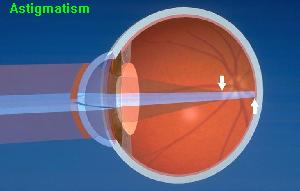A refractive error is a condition in which an eye is not seeing optimally because light is not focusing perfectly on the retina. Anyone needing to wear prescription glasses or contacts has a refractive error. Depending on what kind you might have, you could have blurred vision at a far distance, blurred distance at a near distance, blurred vision at all distances, or just feelings of strain and headache.
Here are the basic categories of refractive error:
Myopia (near-sightedness)
A person who is near-sighted sees better close up than far away. Looking at the eye, light focuses too soon leaving the optimal point of focus too far forward in the eye. This leaves an area of defocus landing on the retina. Lenses with a negative or minus power will extend the focus further back and give a myopic person their best vision.
Hyperopia (far-sightedness)
A person who is far-sighted has an easier time seeing far away than up close. This results in either better vision far away or sometimes just less strain to see far away. Light focuses behind the retina in this case and plus lenses help to bring that focal point closer and land on the retina. The reason a hyperopic person may still see sharp and instead feel more of a strain is because the lens that is in our eye can do that extra focusing for us to a certain degree. Effort must be used though to do this resulting in strain and headaches for some people.
Astigmatism
A person who has astigmatism has lens surfaces that are not evenly curved, somewhat like an egg or a football. This means that light does not focus to a point and every distance is not as sharp as it could be. People who are near-sighted or far-sighted can also have astimatism. Astigmatic people need to wear lenses that vary in power depending on rotation of the lens. these lenses need to sit at a certain orientation in front of the eye to give good vision.
Presbyopia
A person who is presbyopic is usually in their early forties or older. This condition affects everyone, even if you had perfect vision your whole life. The lens inside the eye gets less elastic with time preventing us from adjusting from far vision to near vision as easily or at all. This is when we need a separate prescription for near vision.
All of these conditions can be remedied with glasses, contacts and surgery with certain limitations. After reading this basic article, please feel free to ask questions or come in for an eye exam if things are not as sharp and easy on the eyes as you think they could be.
images courtesy of refractive error basics http://www.eyecaretyler.com/myopia.htm










I was pretty pleased to uncover this great site. I need to thank you for your time due to this fantastic read!!
I definitely liked every little bit of it and i also have you book-marked to check out new stuff in your web site.
I’ve been told I have a very mild astigmatism. Because I get multiple migraines a month I purchased corrective lenses to see if it would help. While wearing the glasses normal straight lines appear distorted, picture looking at the top of a laptop where the left side appears to be about 2-3 degrees lower than the right side. I would not consider my vision to be blurred and I have 20/20 vision in both eyes. I have had my prescription checked by two optometrist to verify the correct prescription. In addition to migraines a few times a month my eyes do something very strange where it appears that objects are higher in my left eye than my right eye creating extremely distorted vision for up to 5 min. My polarized sunglasses (non prescription) have started giving me a headache after about 30 min of wear as well. Is this a sign of a more severe form of astigmatism?
I now have a better understanding of eye imperfection. Thanks for the explanations of different things that could potentially be wrong with your eyesight.